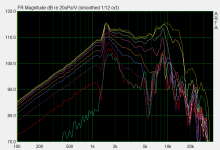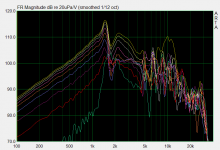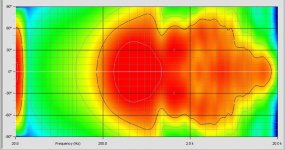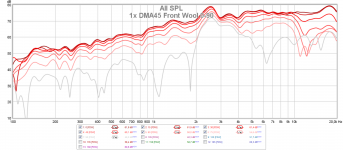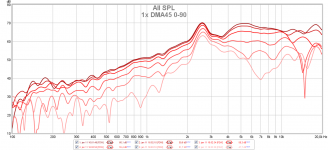Of course I measured distortion =)
The drivers were measured naked and suspended at 50 cm distance. They have moderate EQ applied such that the response targets a flat response with 140 hz 24 dB highpass. They are both given the same signal except that the ND105 has the LR2 highpass shifted from 140 hz to 155 hz as it had a bit more efficiency on the lowest end.
But look at how smooth the DMA90 measures over the whole range! The ND105 has lots of peaks and dips and while it technically has more xmax it isn't as clean, look at those ugly odd order distortion peaks. Unless you have an array of them you probably want to cross them higher thogh to avoid that distortion bump. My current plan is a line of ~ 16 of them where every other driver is inverted to null some of that 2nd order distortion on the low end.
Thanks for posting those. The DMA90 looks pretty good. Probably best used 500Hz and up if you value clean output. I found measurements of the 3" version (DMA80-4) done by VoiceCoil and that had the same hump in distortion, only higher up in frequency and then climbing to as much as 22% distortion below 100Hz!
I'm also interested in the 4" DMA105-4. It should have a similar motor as the DMA90 but with more cone area and the distortion rise should happen lower in frequency. That might make a great mid for a dipole system, and I am always looking for those. Of course I would need to measure the rear side output to see if it meets my needs, etc. but based on the '90 it looks promising.
Is this comparable to XLR being balanced?
So I mean: Let's say every dipole in your array distorts. Then the distortion in the backwave from half of the dipole drivers (which is 180° out-of-phase with the distortion from the front facing ones front-facing ones) cancels out the distortion from the front-facing drivers
Am I getting this right?
Pretty much, it is not an exact equivalent as different things are causing the distortion (motor, suspension, surround and so on) but in practice it is similar as we trade even order distortion for a bit higher odd.
Thanks for posting those. The DMA90 looks pretty good. Probably best used 500Hz and up if you value clean output. I found measurements of the 3" version (DMA80-4) done by VoiceCoil and that had the same hump in distortion, only higher up in frequency and then climbing to as much as 22% distortion below 100Hz!
I'm also interested in the 4" DMA105-4. It should have a similar motor as the DMA90 but with more cone area and the distortion rise should happen lower in frequency. That might make a great mid for a dipole system, and I am always looking for those. Of course I would need to measure the rear side output to see if it meets my needs, etc. but based on the '90 it looks promising.
If you want to use them solo then yeah.
The DMA105 looks very similar so will probably measure almost identically but shifted in frequency. Neither of them have any real low end output unless you combine a lot of them.
I also have a pair of DMA45s on the way, the idea is to see if they can cover 1 khz -20 khz with some help on the rear from ~ 10 khz where I expect them to start to fall off if they measure like the DMA90 but shifted an octave up.
Last edited:
Sounds right to me 🙂 Are omnis very flexible when it comes to positioning?Please correct me if I'm wrong! 🙂
Sounds right to me 🙂 Are omnis very flexible when it comes to positioning?
Not really. AFAIK generally omnis also need some space to breathe. As their position to the wall is reduced, reflections from the wall start to give you a feeling of there being a 'second speaker', which is a generally an undesirable effect. When the speaker is close to the wall, the small delay between the original driver-created audio and the reflection reaching your earis interpreted by our brains as hearing a second source of audio. This undesirable effect can be reduced by placing the speaker farther from the wall, thus increasing the delay, which in turn diminishes the effect.
Some manufacturers have put efforts into working around this effect.
I know that the Ohm Walsh series speakers have a shield at the back side of the omni-driver in order to reduce reflections that radiate to the back against the walls. Just like these Harman Kardon Citation speakers. Omnidirectional speakers As you can see, behind the omni driver there is a baffle that reduces wall-radiation
With dipoles, you want the speaker to radiate backwards, so they need a lot of space behind them. With omnis, you don't generally need them to radiate backwards. Usually, 180°-240° or so dispersion is fine (these numbers are not well-document or anything, it's just my arbitrary guess; point remains the same 🙂 ). Therefore, installing a baffle that limits some direction of dispersion can be very beneficial if you plan to place the speakers close to a wall
Some omnis thrive with space and actually want to be put as close to the middle of a room as possible (which would require some creative interior design, I reckon... hahaha)
It does look like the back of TB 1808 is usable up to about 2K, maybe stretching to 3K. That's amazing. What could you then use as an Omni tweeter?
No no no, tweeter is going to be directional. So lots of options still open. I'll be going with a soft dome tweeter, I know that much, but I haven't made a definitive choice yet 🙂
Would you advise against crossing over ar 8-10kHz? What can I expect from the sound of the driver in the 2k to 8k range? To me, the graphs seem to depict that the sound is mostly there, albeit with some dips and such
Would you advise against crossing over ar 8-10kHz? What can I expect from the sound of the driver in the 2k to 8k range? To me, the graphs seem to depict that the sound is mostly there, albeit with some dips and such
Here's the dilemma:
You can use a monopole tweeter, but you should cross over to it no lower than 5kHz.
The rear output from most woofers used as a dipole starts to strongly deviate from the front output by 2kHz and above that it can be plagued with resonances and other undesirable behavior.
This leaves a gap between 2k and 5k. What to do?
I find that I return to this same problem over and over again: how to address the band above 2k. It's the same whether you will be using a monopole tweeter or go dipole all the way up.
A straightforward way to conceive of a 3- or 4- way dipole system is to expect that there will be a crossover point at 2k. Then it is a matter of deciding how to break up the <2k and >2k band. My opinion is that a dipole tweeter that can cross as low as 2k is the key to making it all work. Consequently, you can cover the band 500-2k or 700-2k using a circa 6" midwoofer with little to no baffle around it, and below that using a larger e.g. 15" woofer, which should be able to get down to below 100Hz. That's your 3-way system. If you want higher SPL, cross over at 100Hz to a dipole or monopole subwoofer for a 4-way system.
I have not seen a coned driver as dipole that is without issues to the rear as high as 5k, and it is a choice to build those issues into the system if you do not have a better choice (e.g. a better driver). I only know a couple of midrange class drivers that I would feel comfortable using above 2k, and they are planars like the Neo10 or the newer Radian LM8k. These will work well up to 5k where you can cross to a monopole tweeter, so that is another way to approach the design.
All of the above is viewed with the perspective that there should be little to no baffle around the drivers and that front and rear radiation should be as similar as possible.
You can use a monopole tweeter, but you should cross over to it no lower than 5kHz.
The rear output from most woofers used as a dipole starts to strongly deviate from the front output by 2kHz and above that it can be plagued with resonances and other undesirable behavior.
This leaves a gap between 2k and 5k. What to do?
I find that I return to this same problem over and over again: how to address the band above 2k. It's the same whether you will be using a monopole tweeter or go dipole all the way up.
A straightforward way to conceive of a 3- or 4- way dipole system is to expect that there will be a crossover point at 2k. Then it is a matter of deciding how to break up the <2k and >2k band. My opinion is that a dipole tweeter that can cross as low as 2k is the key to making it all work. Consequently, you can cover the band 500-2k or 700-2k using a circa 6" midwoofer with little to no baffle around it, and below that using a larger e.g. 15" woofer, which should be able to get down to below 100Hz. That's your 3-way system. If you want higher SPL, cross over at 100Hz to a dipole or monopole subwoofer for a 4-way system.
I have not seen a coned driver as dipole that is without issues to the rear as high as 5k, and it is a choice to build those issues into the system if you do not have a better choice (e.g. a better driver). I only know a couple of midrange class drivers that I would feel comfortable using above 2k, and they are planars like the Neo10 or the newer Radian LM8k. These will work well up to 5k where you can cross to a monopole tweeter, so that is another way to approach the design.
All of the above is viewed with the perspective that there should be little to no baffle around the drivers and that front and rear radiation should be as similar as possible.
The rear output from most woofers used as a dipole starts to strongly deviate from the front output by 2kHz and above that it can be plagued with resonances and other undesirable behavior.
Thank you for the response, CharlieLaub
Do you know what causes this discrepancies between the back wave and the front wave above 2k?
As an example of what I am talking about, here is the rear output from a Dayton DMA90 as posted earlier in this thread. This is a driver that could be used to about 4.5k only from the rear (e.g. mounted face down in a cabinet) if you did not use a low-pass crossover on it.
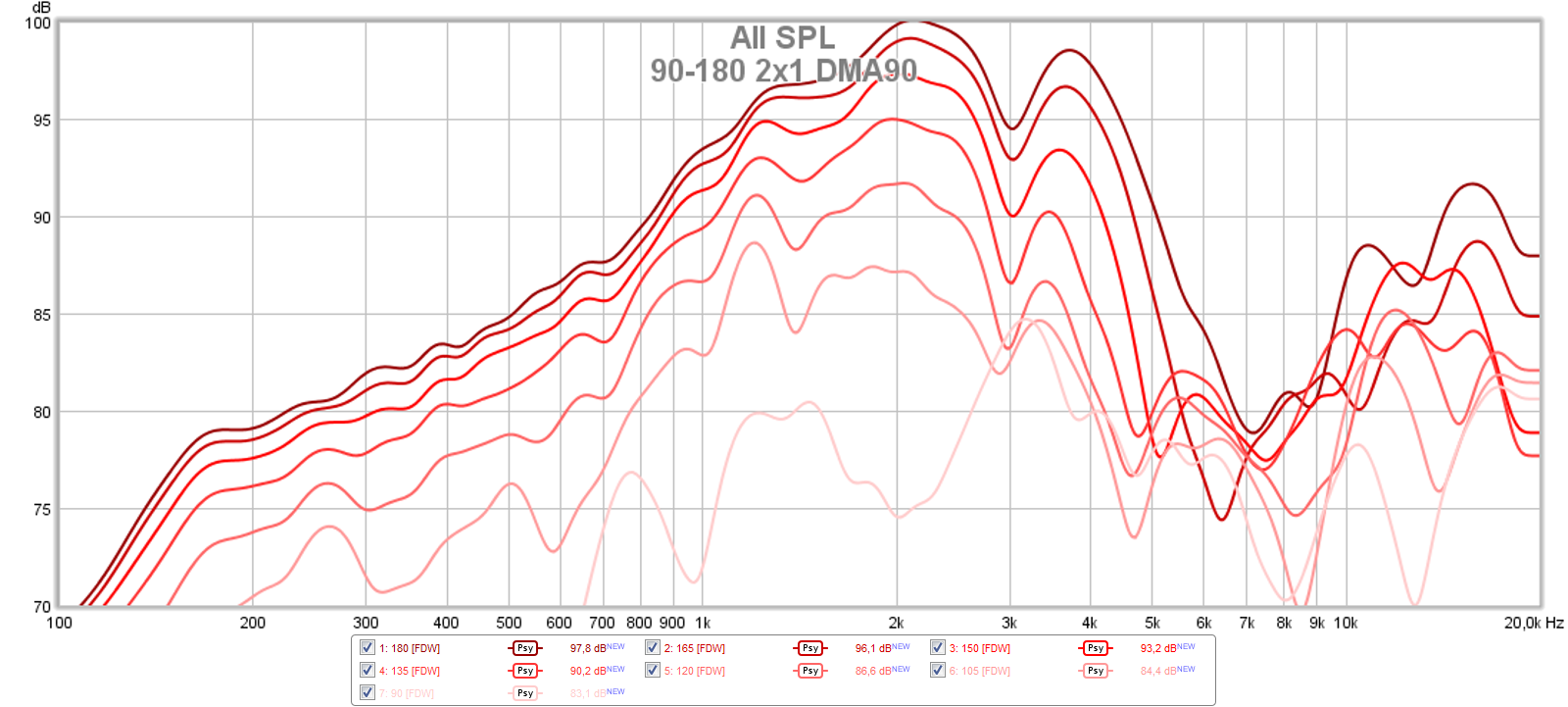
The response is already dropping at 4-5k and maybe this can be used as part of the crossover. You would still want to attenuate the output above about 9k, maybe with a notch filter or if you will use DSP, a high order LP with a sharp corner.
Unfortunately there is the dip at 3k. It happens at the same frequency on all axes so it is a resonance. This hints at energy storage and ringing and 3k is where the ear is still relatively sensitive. It's up to you if you want to build that into your system or not.
The response is already dropping at 4-5k and maybe this can be used as part of the crossover. You would still want to attenuate the output above about 9k, maybe with a notch filter or if you will use DSP, a high order LP with a sharp corner.
Unfortunately there is the dip at 3k. It happens at the same frequency on all axes so it is a resonance. This hints at energy storage and ringing and 3k is where the ear is still relatively sensitive. It's up to you if you want to build that into your system or not.
Thank you for the response, CharlieLaub
Do you know what causes this discrepancies between the back wave and the front wave above 2k?
There is this big magnet thingy and the frame/basket next to the rear of the cone... they are the likely culprits.
It seems that you cannot tell by looking at a driver whether it will have smooth rear output and at what frequencies there might be issues. For example, I bought a pair of SB Acoustics MR13P-4. Take a look at this driver (below) - it has what looks to be a very aerodynamic motor and open basket. I thought that it would "play nice" as a dipole. But when I measured it I was clear that this would not work well from the rear and would not be easy to use as a dipole (see attached measurements). The rear response has the sharp dip at about 1.8k Hz.
An externally hosted image should be here but it was not working when we last tested it.
This is a very nice driver, but I wouldn't use it "nude" in a dipole system because of the issues with its response, both to the front and rear. Those sharp features are really problematic...
Also, I should mention that it is very important to take high resolution measurements to spot narrow features. These measurements were taken outdoors with the driver hanging in free space and probably have a 20Hz resolution. When I started measuring in this way, I found all sorts of things that I had not seen before at lower resolution and it really helped to separate the winners from the not-so-greats.
Attachments
@CharlieLaub
Ahh I see, well this doesn't predict much good for the tangband then (per the graphs I poster earlier). It seems the back wave stores energy at 5k and to a lesser extent also at 3k. Furthermore, it looks like the graphs are in agreement with what you were saying: all good up to 2k, then some bothersome interferences of sorts
This helped me interpret the graphs, thank you 🙂
Raoul
Ahh I see, well this doesn't predict much good for the tangband then (per the graphs I poster earlier). It seems the back wave stores energy at 5k and to a lesser extent also at 3k. Furthermore, it looks like the graphs are in agreement with what you were saying: all good up to 2k, then some bothersome interferences of sorts
This helped me interpret the graphs, thank you 🙂
Raoul
Exactly. It's the the graphs. well behaved up to 2K then it falls apart, which is why I suggested 2K as a safe spot to cross. There is output above 2K, but it probably doesn't sound good.all good up to 2k, then some bothersome interferences of sortsl
Making an ideal broadband dipole would seem to be challenging, looking at an H-polar for Linkwitz Orion.Whilst moving around them the output will vary but the spectral balance should ideally remain the same.
However SL created a baffle that is far from axissymetrical so single plane analysis seems far from the correct way to look at it.
Attachments
You won't find ordered geometric distributions of the reflections (except specific pseudo-random findings), as speaker/room is an arbitrary interface.Sounds right to me 🙂 Are omnis very flexible when it comes to positioning?
Making an ideal broadband dipole would seem to be challenging, looking at an H-polar for Linkwitz Orion.
However SL created a baffle that is far from axissymetrical so single plane analysis seems far from the correct way to look at it.
Yeah, but even that is hiding that the 8" woofer which on the front can cover up to 1440 hz it doesn't work that well on the rear. *I expect that the rear off-axis response will begin to fall sharply at around 800 hz.
*(I have not measured Orion myself so this is a prediction based on how other drivers like the DMA90 but shifted in frequency has performed)
Alright, I have now measured the DMA45 to see if the niceness of the DMA90 is kept but up to an octave higher.
As far as I can see the answer is no. It is good though, if the 2-4 khz off axis bump could be handled but it is not as turnkey as the DMA90.
The last measurement is the driver naked without any wool, pretty much the same but sharper peaks.
As far as I can see the answer is no. It is good though, if the 2-4 khz off axis bump could be handled but it is not as turnkey as the DMA90.
The last measurement is the driver naked without any wool, pretty much the same but sharper peaks.
Attachments
Last edited:
- Home
- Loudspeakers
- Multi-Way
- back wave in comparison to front wave
